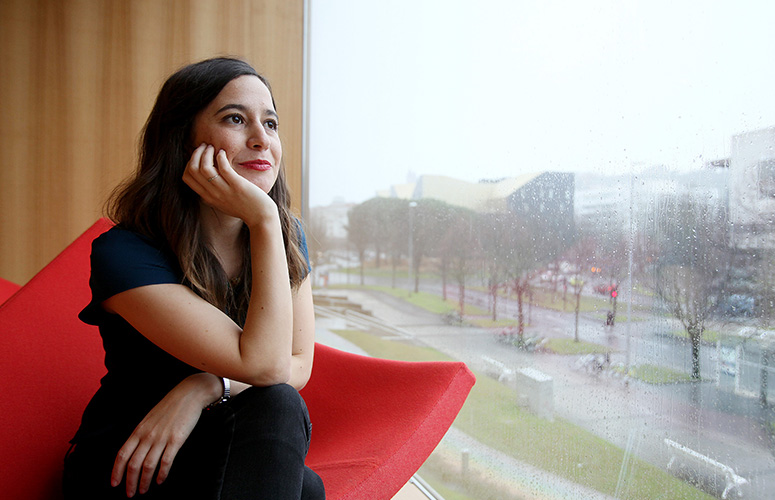Over a two-year-period a researcher in the UPV/EHU’s DREAM group analysed in depth the students’ language behaviour in a classroom at a school in Bizkaia, and the result is an ethnographic analysis of the inside of the classroom. The researcher regards it as a photograph of a specific moment and group, but it reveals very interesting data on the opportunities offered by multilingualism as well as on the position the Basque language needs to adopt.
-

Cells very similar to neurons obtained from human dental stem cells
-

The brain resorts to myelin when other brain nutrients are depleted
-

System for calculating the impacts of emissions by large European industrial plants is published
-

Most goals in football result from first touch shots
-

Añana Saltern microorganisms help to clarify the groundwater flow pattern
Although students are aware of the vulnerability Basque is exposed to, they don’t use it
A researcher at the UPV/EHU-University of the Basque Country explores language use, identity and code-switching among students in a classroom at a school in Bizkaia
- Research
First publication date: 17/02/2020

The researcher Eider Saragueta, a member of the DREAM research group of the Department of Research Methods and Diagnostics in Education of the UPV/EHU’s Faculty of Education, Philosophy and Anthropology, monitored the students in a classroom at a school within the “D” (Basque-medium education) education model in a village in Bizkaia during the years they were in the 5th and 6th years of primary education. “I produced an ethnographic analysis, in other words, an in-depth study in which I was able not only to monitor the students’ language uses but also to conduct interviews and even make the occasional intervention to reinforce ties between different languages,” she remarked.
One of the reasons prompting her to embark on this research was, as the researcher stresses, “the perception around me among the general public, but also in the institutions, of a concern about Basque use: despite the fact that more and more people speak Basque, its use has not increased to the same degree. So the aim was to produce a photograph of a specific school at a specific moment and see the students’ language practices in order to get first-hand knowledge about the use they make of Basque”.
Saragueta’s study was not restricted to examining Basque use; it also analysed the identity of the students, focussing on how the various languages they speak influence their identity. As the same time, some classroom activities were planned in which translanguaging or code-switching among various languages took place. “In these exercises the students received information in one language and had to transmit it in another. That way they can make use of the language they master to learn another”, she explained.
Imbalance between language use and awareness
The study was very deep and extensive and produced a range of results, but what caught Saragueta’s attention in particular was “the huge imbalance” that she found “between the students’ use of Basque and their awareness of the language: they knew perfectly well that Basque is a minoritized language, some of them were in no doubt that it is endangered… but even so, they did not speak in Basque”.
With respect to identity, the researcher found huge diversity: “Some of the students had a rigid sense of identity and identified themselves exclusively as Basque. But there were some who felt identified with looser identities and displayed a broader identity; they pointed out, for example, that they certainly felt they were Basque but because their family was from Extremadura, they also felt they partly belonged there. I think that it is very positive that 10-12-year-olds are capable of moulding their identity in this way; in other words, that they should have sufficient flexibility to adapt their identity to the situation and moment they find themselves in and that they are aware of this,” she remarked.
Then, “engaging in translanguaging activities and taking advantage of the students’ multilingualism has helped to give value to the use of the different languages they speak,” said Saragueta, and she gave an example to illustrate this: “If in order to learn English they watch a video in that language, they may not understand what is being said, they may get lost and end up getting bored. But if they see the same video in Basque, and then answer some questions relating to it in English, they will seek the necessary lexical resources and that way will end up learning English. In other words, they can use one language as a crutch to learn others”.
Translanguaging also helps them to develop language awareness, and they display sensitivity towards all the languages around them, and even towards other cultures. “Among the activities we did there was one on language biography; the students said which languages they spoke at school, outside school and at home. As soon as languages have a presence in the classroom, the students’ language awareness increases, and I believe that could open up the door to coexistence, although I did not have the chance to further this aspect in my research,” explained the expert.
So the researcher regards enhancing multilingualism and using it in education as “very useful and interesting, but one needs to be clear that Basque needs to be the hub and the centre and that spaces for protecting the language need to be created”.

